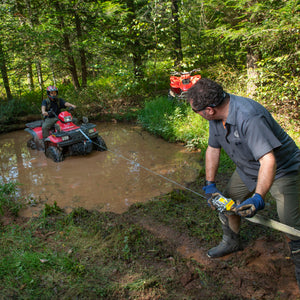Understanding Lug-All Winch-Hoist Capacity

One of the unique features of Lug-All Come Along Ratchet Winch Hoists is right there in the name; it is both a winch and a hoist in one tool. The difference between winching and hoisting is simply the direction the tool is pulling a load. If it is lifting vertically, it’s hoisting; if it is pulling horizontally, it’s winching.
Because Lug-All Winch Hoists are designed to do both tasks, both tasks must be considered in the design and construction of every Lug-All. Lug-All Winch Hoists are used by different people for winching, hoisting, or both, depending on the application, so users need to know the maximum safe load they can lift or pull.
Users who perform vertical lifts with their Lug-All Winch Hoists need to know exactly how much they can lift, so the capacity rating reflects the maximum load that can be lifted. The Lug-All 4000-20, with a 4,000-pound capacity, is able to lift 4,000 pounds vertically. The Lug-All 25-A, with a 3,000-pound capacity, is able to lift 3,000 pounds vertically. This system of capacity rating applies to every Lug-All Winch Hoist.
However, many applications do not require vertical lifting. Many users use their Lug-All Winch Hoists for pulling as well as lifting, or even for pulling only. For people who use Lug-All Winch Hoists primarily for pulling, the vertical lifting capacity isn’t as important. What is important is how much weight the winch hoist can pull horizontally.
The answer to this question is that it depends on the specific winch hoist as well as the situation. In most instances when a winch hoist is used for pulling instead of lifting, it can handle heavier objects than it would when lifting. The amount of weight a winch hoist can handle when pulling depends on several factors, such as the hoist model, the angle of pull, the surface the load is on, and other considerations.
Force Required to Pull
Two of the most important factors to consider when determining potential pulling force are the degree of incline or decline and the coefficient of friction between the surface and the object being pulled. As the angle of the pull becomes steeper, the force required to pull the object becomes closer to the force required for a vertical lift. Similarly, a greater coefficient of friction will increase the pulling force, potentially reaching the capacity of the winch hoist.
We’ll use a car weighing 4,000 pounds as an example. If the car is resting on a flat road, with the wheels rolling, it will require about 120 pounds to pull it (Illustration A). The resistance of rolling tires on a flat road is very low, and there is no vertical component to the pull, so the total force remains very low.
If the same car is on a 30-degree incline (Illustration B), there is a significant vertical component to the pull, which increases the total required force to about 2,098 pounds. Because the wheels are still turning, there is still very little resistance from friction.
These numbers change significantly if the wheels on the car are not rolling. The coefficient of friction between rubber and asphalt is fairly high, so the resistance from friction is high. The force required to pull the same car on a flat road without the wheels rolling would be about 2,394 pounds (Illustration C).
If we put the car on a 30-degree incline again, this time without the wheels rolling (Illustration D), we have the same vertical component to the pull as well as the high resistance from friction. With these two factors, the force required to pull the car would be about 4,068 pounds.

If we are using a 4,000-pound capacity come along, we can see in Illustrations A, B, and C that the required force to pull the car is substantially less than the capacity, even though the car itself weighs 4,000 pounds. These examples demonstrate how a Lug-All winch hoist can often pull an object that weighs more than the rated lifting capacity.
Using the same 4,000-pound capacity come along, we can also see that the force required in Illustration D is over the capacity. This problem is where we encounter one of the most important differences between Lug-All and other come along manufacturers, and that is overload protection. Many hardware store come alongs will fail when they reach their maximum capacity, but Lug-All come alongs are equipped with overload protection systems that alert the user when the load is over the rated capacity.
In short, the force required to lift an object is equal to the weight of the object, but Illustrations A, B, and C demonstrate how the force required to pull an object can often be less than the weight of the object. The rated capacity of a Lug-All Winch Hoist is based on the maximum force it can exert for lifting an object, which is why, in most cases, it can pull heavier objects than it can lift.
